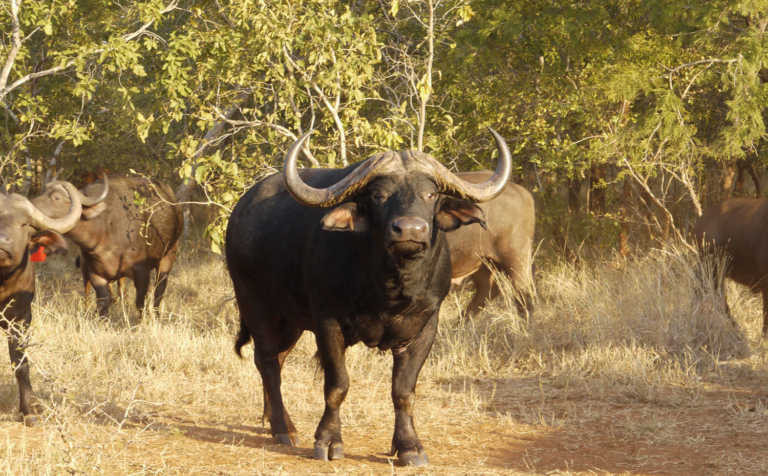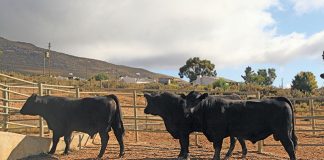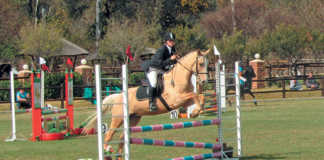
Photo: FW Archive
What is the current size of South Africa’s buffalo industry?
The country has about 2 500 registered buffalo farms. The privately owned, disease-free buffalo population is estimated at 50 000 to 70 000 animals.
How accessible is the buffalo breeding industry for the less affluent, given that some bulls sell for millions of rand?
We need to differentiate between stud and commercial breeders. Stud breeders easily pay R5 million for an outstanding bull and R1 million for a cow or heifer. I know of only 22 buffalo bulls with horns exceeding 50” [127cm] in the entire country. Such bulls are rare and therefore very expensive. But this may create the perception that buffalo breeding is restricted to the super-rich.
The capital outlay for initial stud breeding stock is substantial. Stud breeders are not interested in bulls with horns measuring less than 48”, according to the measurement convention used in Rowland Ward’s Records of Big Game [RW], which records the measurements of game animals taken in fair-chase hunting, or less than 126”, according to the measurement convention used by Safari Club International (SCI). Pedigree, fertility and pre-potency also have an influence on the spectacular sums paid for outstanding genetics.
Commercial breeders mostly produce bulls for the hunting market. There is a huge shortage on the African continent, and hard-bossed hunting bulls sell for R80 000 to R200 000 each.
The generally accepted norm is that the monetary value of a bull should equate to the reasonable market value of 10 to 15 of his offspring. Most commercial buffalo breeders are willing to pay between R500 000 and R1 million for a breeding bull.
A new entrant to the commercial buffalo industry can acquire a bull, as well as 10 to 20 breeding cows, for between R2 million and R3,5 million. New entrants find this segment much more accessible and affordable.
What contribution does the hunting of Cape buffalo make to the total hunting industry in South Africa?
The Cape buffalo occupies a top spot on most hunters’ wish lists. After Canada, South Africa is the number one hunting destination for Americans and their preferred African destination by far.
South Africa’s variety of 45 major plains game species, the Big Five, abundance of good-quality trophy animals, excellent infrastructure, and good medical care are all cited as major attractions for US hunters.
Cape buffalo contributed 12%, or R145 million, to South Africa’s R1,2 billion annual foreign currency earnings from trophy hunting in 2015. This makes it the second-biggest earner after lion hunting, which contributed R181 million.
How does the local hunting industry compare with buffalo hunting in the rest of Africa, such as in Kenya?
The sustainable utilisation of Africa’s wildlife is a vital component of its conservation. In countries where hunting has been banned, wildlife numbers have crashed.
Where hunting is legal, wildlife populations are booming. Kenya introduced a total ban on hunting in the 1970s and its wildlife has suffered severely as a result. On the contrary, South Africa now has more wildlife than 150 years ago.
According to the RW, during the past 15 years, South Africa has moved from the fifth-highest to the third-highest position for the number of buffalo hunted as trophies, surpassing Zambia and Zimbabwe.
I expect the gap between South Africa and Tanzania, as well as Kenya, to narrow significantly, and the gap between South Africa and Zimbabwe, Zambia and Mozambique to widen.
This is because South Africa is the only country on the continent where active breeding efforts have resulted in significant growth in the buffalo population. Between 1896 and 2000, fewer than 7% of all RW trophies were hunted in South Africa. In the short time since, this has increased to 44%.
You said that horn sizes of buffalo trophies had declined over the past 50 years. Please explain why this has happened.
Studies from other African countries demonstrate a decline in trophy quality. Muposhi et al (2016) found that the trophy quality of elephant, buffalo, kudu and sable antelope taken in the Matetsi Safari Area in Zimbabwe had decreased.
A Tanzanian study (Wilfred, 2012) reached the same conclusion for buffalo, impala, warthog and kudu.
Legal hunting, as described above, generally affects wildlife populations positively.
However, in the case of buffalo, it probably contributed to this decline. Careful analysis of the photographs of the SCI top six-ranked buffalo bulls shows that five of them were probably hunted younger than 7,5 years, well before they earned breeding status.
The long-term effect of this negative and unsustainable selection method obviously caused this general decline in trophy quality.
What mistakes have been made in buffalo breeding?
The biggest known buffalo bull alive today measures between 55” and 56”, which is 6” short of the RW record. Of the 697 bulls in the RW book, 214 measured less than 47”. The average breeding bull in South Africa today is probably between 43” and 45”.
As a result of poaching and diseases such as bovine tuberculosis, the bulls in our game parks and other African countries probably measure even less.
Therefore, the average buffalo bull alive today has far smaller horns than his counterpart of a century ago. Using horn spread as a major selection criterion is thus fully justifiable.
One of our mistakes is that we are ineffective in countering the propaganda of those implying that we are fixated on horn selection only and that this will eventually result in ill-adapted, inbred, disease-prone animals.
Buffalo breeders, hunting outfitters and everybody in the wildlife value chain must collaborate closely to promote the magnificent and well-balanced buffalo specimens that are produced in our extensive breeding and hunting operations.
What would be the best-case scenario for the buffalo breeding and hunting industry in the next decade?
The continued legal protection of individual property rights is first and foremost. Second is the expansion of the Veterinary Procedure Notice, which controls buffalo testing and movement, to include greater levels of self-regulation.
This needs to happen as soon as possible as it will facilitate the trade of buffalo between existing buffalo owners, and easier trade will in turn attract new entrants.
Third, in the best-case scenario, the permit system is streamlined without sacrificing proper disease control measures. Currently, the movement of a buffalo between two provinces requires approvals from the directors of veterinary services of both provinces, an import permit from the department of environmental affairs in the destination province, and an export permit from the province of origin. This means approvals from at least four separate government offices.
In addition, a registered breeder with more than one approved buffalo property is unable to move buffalo between his own farms without going through this time-consuming and expensive testing and quarantine protocol.
In the latter scenario, a buffalo breeder, at his own risk, should be allowed to move buffalo with the necessary approvals and permits, but without the requirement to have them tested again.
Lastly, game ranchers, outfitters, professional hunters and [casual] hunters need to work together to uphold fair-chase principles and promote South Africa accordingly.
Fair chase is the ethical, sportsmanlike and lawful pursuit and hunting of any wild big-game animal in an area large enough and in a manner that does not give the hunter an improper advantage.
It is crucial for buffalo breeders to supply the hunting market with unadulterated wild animals rather than semi-domesticated specimens raised on supplementary feed and in constant close proximity to humans.
Email Dr Johan Rabie at [email protected].











